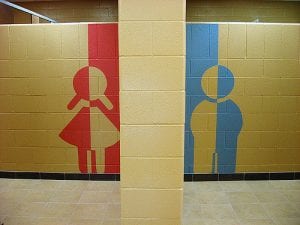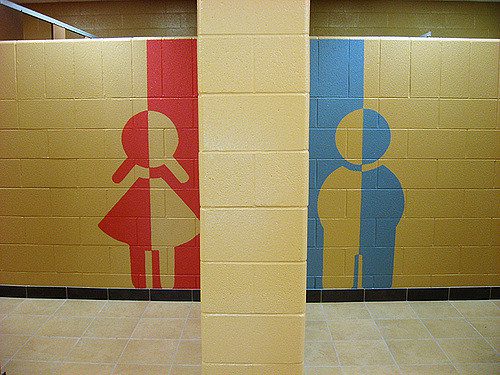
Photo by Jodi Green via flickr, CC BY-NC-ND 2.0
The transformation of previously disinvested urban centers by gentrification has become increasingly widespread over the past decade. While the benefits and drawbacks have been discussed at length, one aspect has been largely overlooked: gentrification’s effect on neighborhood schools.
Neighborhoods that gentrify usually benefit from new services and amenities like grocery stores and other retail within walking distance, better public transit connections, reduced crime, and perhaps most importantly, attention from local government. But does an influx of affluent residents and their children have a beneficial effect on local public schools?
While in many cases gentrification usually stops at the schoolhouse door, in our recent study of Washington, D.C.’s most rapidly gentrifying neighborhoods, we found that as many of the city’s neighborhoods have become more racially diverse, racial school segregation has declined. This is a promising development since desegregated schools are strongly linked with numerous positive outcomes, including higher academic achievement, a reduction in racial prejudice, higher levels of civic engagement, and a greater likelihood of students living and working in diverse environments later in life.
Our analysis of neighborhoods in Washington, D.C.’s fastest gentrifying areas showed that the white population increased in those places from approximately 5 percent in 2000 to almost 50 percent in 2015. During this same period, the white public school enrollment in the same areas increased from 1 to 8 percent. While the increase in the percentage of white students is not as large as the neighborhood level changes, it is a sign that white parents are beginning to engage with the local schools. It also means that racial segregation in these increasingly diverse neighborhoods is on the decline.
While our data from D.C. schools show that segregation still persists at high levels in both charters and traditional public schools, segregation levels have declined more substantially in traditional public schools (TPSs) than in charters. Between 2007 and 2014, the share of hyper-segregated TPSs (meaning 90 percent or more of students are of color), fell from 67 to 41 percent. During the same time, the share of hyper-segregated charter schools in D.C.’s gentrifying areas declined more modestly, from 77 to 70 percent.
While these changes present an opportunity to integrate previously segregated schools, we must ensure that the process is managed through coordinated and targeted policies to ensure that it creates inclusive communities rather than displacing lower-income residents.
As white, middle-class young adults who grew up in the suburbs are increasingly opting for city living and settling into urban neighborhoods, evidence shows they are enrolling their children in the local public schools. This prospect suggests that cities and school districts have a unique opportunity to figure out how to leverage the arrival of affluent families who are willing to bet on public schools before this diversity disappears and classrooms become majority white. The challenge requires creative policies that underscore the deep and fundamental relationships between housing and schools. In 2016, the Department of Housing and Urban Development engaged in dialogue discussing how gentrifying neighborhoods can manage change in ways that keep communities inclusive, affordable, dynamic, and diverse.
Most cities and districts experiencing rapid gentrification haven’t yet figured out what those policies might look like, but some are trying to develop them. Denver public schools recently launched the Strengthening Neighborhoods Initiative, a citywide effort to look at how rapid gentrification is changing Denver’s public schools, come up with ideas to combat its most pernicious effects, and integrate previously de facto segregated schools. Their strategies include redrawing school boundary lines, system priorities for socio-economic status, innovative transportation solutions, and the creation of new and specialized schools.
For schools to capitalize on the integrative possibilities of this wave of urban gentrification, they need a strategy to attract newcomers while also encouraging positive diversity. They must avoid becoming “boutique schools,” —catering to the upper-middle class which has isolated itself both racially and economically as the neighborhood changes around them.
Magnet schools and dual language programs can have strong integrative possibilities. Research asserts that magnet schools, which provide specialized curricula to attract students from a variety of backgrounds, can provide integrated, higher-quality schooling for low-income students living in gentrifying neighborhoods when compared with non-specialized public schools. School and community leaders should also focus on the development and promotion of dual language schools, as studies have found links between their graduates and future employment opportunities and better salaries.
Despite research that points toward integration as the best way to improve future opportunities for poor and minority children, policymakers have, for the most part, abandoned this aspect of schooling. Attracting the new middle-class families in a gentrifying area to the local schools has the potential to create educational integration. These families can increase financial support for the schools, and foster peer groups that accelerate educational gains and numerous positive outcomes for all students. However, successful management of the gentrification process is essential to ensure that it creates inclusive communities rather than displacing low-income residents and residents of color.






I am not good with data analysis but I do know DC. There are two problems generally with this conceptually. First, a majority of the students in DC schools come from areas of the city that aren’t “gentrifying.” And the schools in the areas that aren’t “gentrifying” aren’t receiving the kinds of necessary investments to improve them regardless of neighborhood improvement effects: https://urbanplacesandspaces.blogspot.com/2017/01/fawning-coverage-of-dc-school-reform.html
Second, the city’s school “system” has been bifurcated into two. One is the traditional system. The second is a non-system of independent charter schools mostly funded by the city. Charter schools do not have a neighborhood preferencing system for enrollment, which further disconnects these schools as civic institutions generally, but also from the neighborhood improvements that result from inward investment (frankly, I prefer the defining of this phenomenon more in terms of city or urban reinvestment rather than gentrification).
And how does one deal with neighborhood improvement happening and improving “neighborhood schools” after once traditional DCPS schools have already been closed and replaced with charter schools.
Concerning segregation versus desegregation, many middle and upper class households send their kids to charter schools rather than to traditional public schools. (Creating in the process, a big transportation problem compared to a neighborhood school centric system.) It’s only a fluke that 5 of the 7 school aged children on my block go to the same charter school. Typically, school aged children on one block go to many different schools.
The worst thing in my opinion from charterization is the atomization of organizational, community, and social capital between public schools and charter schools as well as the decoupling of schools from the system of neighborhood improvement.
This is accentuated by a failure in neighborhood planning systems to prioritize the maintenance of high quality neighborhood schools as a building block for place, community, and neighborhood improvement:
https://urbanplacesandspaces.blogspot.com/2011/07/rethinking-community-planning-around.html
This further reduces the amount of social, organizational, and community capital available in the most challenged neighborhoods, areas where such resources tend to be in shorter supply anyway. https://urbanplacesandspaces.blogspot.com/2011/08/black-social-capital-positive-deviance.html
This is exacerbated by the fact that charter schools are allowed to open without regard to their enrollment impact on existing schools, which further destabilizes public schools. e.g., https://urbanplacesandspaces.blogspot.com/2014/09/applying-ceqa-urban-decay-concept-to-dc.html
Anyway, I think my answer to the headline is “no.” The neighborhoods that were improving or already in a much better place aren’t the places where the most neighborhood improvements are needed in terms of school improvements. And those places aren’t changing fast enough for the schools to improve without exxtranormal inputs, which the city school system hasn’t been providing.
Cf. this fascinating article about a Title I school in Montgomery County, Maryland, north of DC, and one of the richest counties in the US. When I shared it with someone who worked in MoCo and now works for DCPS she said “DC has more resources in the schools compared to Montgomery County, but the County School System uses their resources much better and with greater effect.”
https://urbanplacesandspaces.blogspot.com/2018/01/brilliant-piece-in-bethesda-magazine-on.html
Sadly, for whatever reason, DC has been very bad at capturing the evident best practice concerning schooling in the region’s schools, including Montgomery County, Maryland
https://www.edweek.org/ew/articles/2008/02/20/24zones.h27.html?qs=montgomery+county+maryland
and Arlington County, Virginia. See the discussion of Supt. Robert Smith within this article:
https://www.washingtonpost.com/wp-dyn/content/article/2009/04/02/AR2009040202589.html
Thank you Kfir for pulling together all of these ongoing attempts to deal with gentrification. Santa Fe NM is just waking to the amazing opportunity of our current Midtown Redevelopment. With 16 schools in the area, 5 private, 9 public, and 2 higher ed, the opportunity is to transform suburbia into a sustainable neighborhood. Over the last 40 years, gentrification has displaced the Hispanic locals out of the east side. Hopefully, we can learn from the past, and the efforts in DC and Denver, to make choices that enhance our diversity and quality of life for the generations to come.
I’m leading an Asset-Based Community Development Process to gather and connect the strengths of the students, neighbors, business organizations, and employees into an Integrated Design Process that leads to a Midtown Sustainable Village; Mixed-use, mixed-income, walkable neighborhood with onsite, integrated food, energy, water, solid waste, transportation, and internet systems. Taming gentrification is one of the many essential pieces of the puzzle.
As a long time subscriber, it’s great having Shelterforce still bringing the goods!
There has long been a strong connection between racial segregation and the lack of investment in lower-income communities. Still, I live in hope that, rather than being displaced, the lowest income parents and people of color could benefit from more investment in their historical communities, better transit, and increased attention from government.
The overall theme of this article is on target. Places of concentrated poverty profoundly hurt large numbers of children who live in them. It shows up in their educational and health outcomes. The answer to displacement is more density, more subsidy, and more economic diversity in newly attractive locations- not preservation of a bad status quo. I do challenge this aspect of the article: why are all the demographics measured by race instead of socio-economic status? The author seems to equate black with poor, and white with wealthy; ignoring the presence of long-established middle class black communities in neighborhoods such Brookland and Capitol Hill.
This is a dangerous position. It seems to suggest a return to the old belief that integration is the solution to the education crisis for Black children without addressing the real issues of insufficient funding, understaffing, poor facilities, and other related environmental issues. Where has there ever been “successful management of the gentrification process”? All children need real investment in their education, adequate resources, caring individuals — and not just because there’s an influx of white, middle-class families.